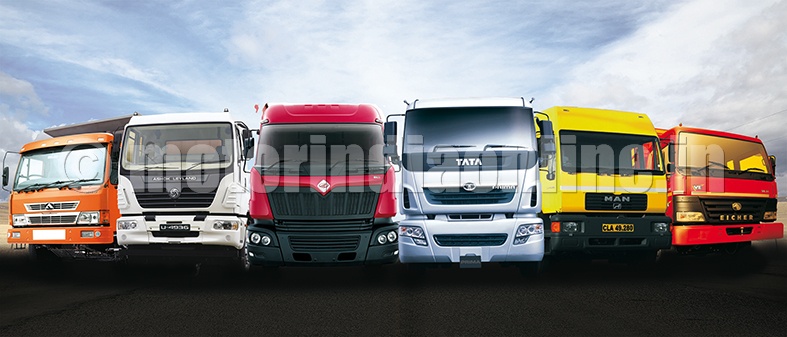The Indian commercial vehicle industry which has witnessed a much-awaited recovery this year after two extremely challenging years is tipped to hit the fast lane in the second half of the current decade. The overall M&HCV market is expected to touch 385,000 units by 2020, says the recently-released ‘M&HCV Industry Paper’ by Roland Berger Strategy Consultants. The report gives a comprehensive picture of the domestic M&HCV market and touches upon various aspects, including the market turnaround, OEM strategies, major challenges in achieving growth and also a to-do list for the different stakeholders in the segment.
After two years of de-growth, the Indian economy is showing signs of modest recovery with all key indicators improving over the last quarter or so. The fact that the GDP growth has crossed five per cent after a gap of more than two years is great news for the M&HCV segment since its growth is highly correlated with the growth in GDP, with the cargo segment having near perfect positive correlation with the GDP growth rate. As the economy recovers, the M&HCV cargo segment is expected to be the first segment within the CV industry to rebound, says the report.
Key outcomes of the study
* Overall the M&HCV industry will continue to grow and there is plenty of positive opportunity in India.
* The market environment in India is still not out of the woods. Significant challenges exist for OEMs, extending to the dealers, suppliers and transporters. In the current environment where bottom-line pressures are high, capacity utilization is a major issue.
* Focused efforts by OEMs, transporters and the government are necessary.

Back to growth
The M&HCV cargo segment has already shown signs of recovery with nearly 21 per cent growth YoY in FY15 after continuous decline since FY12. Within the segment, rigid vehicles account for around 50 per cent of the share followed by ICV cargo at 19 per cent. The segment which registered the highest growth last year is haulage tractors growing by a remarkable 105 per cent.
The overall M&HCV segment is projected to grow at around 11 per cent till FY2020 which will see its volume rise to close to 385,000 units from around 233,000 units in FY15. The cargo segment which currently accounts for nearly 84 per cent of the M&HCV market will be one of the key contributors to the expected growth, the report reveals.
“We expect the overall M&HCV segment to reach close to 385,000 units in 2020 which will be 10-15 per cent higher than the previous peak of close to 300,000 units in FY12. For this to happen the overall economy has to grow at 7-8 per cent and the government needs to take the right decisions and drive business-friendly policies. The Government should not only announce major initiatives but also ensure they execute the same. Overall, the market is attractive and the industry will continue to grow, but the recovery will take some time”, explained Dr. Wilfried Aulbur, Managing Partner, Roland Berger Strategy Consultants, while presenting the report to the media in Chennai.
The M&HCV cargo segment is expected to grow at around 12 per cent over the next five years with customer preference for higher tonnage vehicles and revival of the mining/construction sector driving growth in the haulage segment.
Though the CV sales have seen a turnaround in FY15, most of it has been driven by replacement demand from transporters which indicates that new fleet addition has not quite happened. While fuel price reduction is a major factor leading to the revival of vehicle sales, the excise duty hike has also helped improve sentiments.
With most of the action taking place in the high-tonnage segment, the report indicates that the market trend will be more towards higher tonnage vehicles in future. While the 53 per cent growth in the 31-ton rigid segment is a perfect indicator of the shift towards higher tonnage trucks, key factors such as infrastructure development, ban on overloading and GST implementation will strengthen the shift.
The fact that the average distance covered by an Indian truck driver in a year is 80,000 km as against the global average of 500,000 km goes to show the kind of inefficiencies in the country’s transport system, primarily the poor road infrastructure. GST, if implemented, will not only help bring down logistics costs and improve the overall efficiency of the system, but also attract more drivers into the system. This would be a major step forward in tackling the burning issue of driver shortage.
From a more global standpoint, the Indian market seems to be in a better position at least as far as the BRICS countries are concerned. “The Indian GDP growth rate has stabilized which is a bright spot. With China coming down as far as growth is concerned, the GDP is going down in Brazil while Russia and South Africa remain a question mark. So in terms of the BRICS environment, India is doing well. But the question is are we doing well enough to really create a major impact for FDI as well as a clear improvement of GDP per capita in the country itself”, Dr. Aulbur added.
Assuming the key stakeholders in the industry, including the Government, the OEMs and the transporters take the right measures to drive growth, the Indian CV industry is certain to scale new heights by the turn of the decade.
Roland Berger recommendations
* OEMs should move the focus away from discounting and rely on value addition and aftersales services as key differentiator
* Transporters should proactively invest in enhancing their fleet
* The Government should continue to focus on pro-growth initiatives and improve the toll systems
